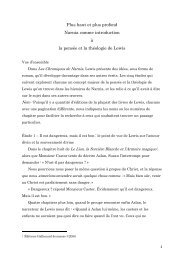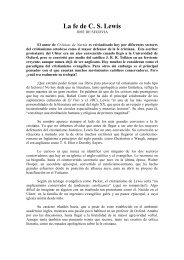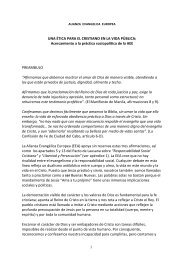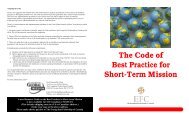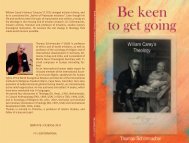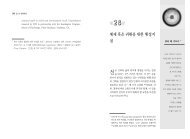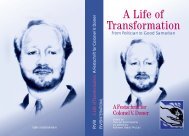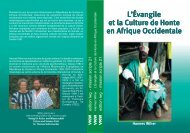WHEN YOU CROSS CULTURES - World Evangelical Alliance
WHEN YOU CROSS CULTURES - World Evangelical Alliance
WHEN YOU CROSS CULTURES - World Evangelical Alliance
Create successful ePaper yourself
Turn your PDF publications into a flip-book with our unique Google optimized e-Paper software.
OTHER QUALITIES AND QUALIFICATIONS<br />
4 Language Aptitude<br />
Although some people have better language aptitude than others, expect<br />
language learning to be hard work and practice. Because learning a language is<br />
a necessity for cross-cultural work, it would be advisable to test one’s language<br />
aptitude. Some people have difficulty in hearing different sounds; others have<br />
difficulty in pronouncing words accurately. Some languages are also more<br />
difficult to learn than others.<br />
There are some good language schemes. One that is commonly used is<br />
the LAMP (Language Acquisition Made Practical) method. It was devised by<br />
E. Thomas Brewster and his wife Elizabeth S. Brewster to help missionaries<br />
develop effective techniques for learning any language. 1<br />
Their textbook Language Acquisition Made Practical (LAMP) describes<br />
their technique for creative language learning. The method emphasises speaking<br />
the new language right from the start and this gives motivation for the learner.<br />
Language helpers are alongside to help the learners practise. The course<br />
attempts to link language learning with the broader culture.<br />
One of my Asian colleagues studied a new language using LAMP. He<br />
found that, though LAMP had many strengths, the method had some<br />
limitations. It assumed that language learners could teach themselves with<br />
minimal help from language teachers. This assumes the learner has had linguistic<br />
training to know what to look for. The method also suggests that the traditional<br />
classroom approach is ineffective. My Asian colleague together with his field<br />
leader modified their language learning approach by incorporating the study<br />
of language structures, a syllabus of topics and a weekly evaluation. They used<br />
part of the classroom approach.<br />
In language learning, methodology is only one of the considerations.<br />
Other considerations are language aptitude, maximum exposure and language<br />
immersion, full time disciplines, and motivation. The degree of difficulty or<br />
ease in learning a particular language is obviously a major one too.<br />
Sometimes candidates with a low linguistic aptitude have been sent to<br />
countries with difficult languages to learn. Occasionally a person has been able<br />
to perform well in spite of language limitations because of other exceptional<br />
qualities. But there have been other situations when a good candidate has had<br />
to return from the field early because of language difficulties.<br />
Others remain longer and prolong their frustration as they struggle with<br />
language learning. The time taken may have diminishing returns both in the<br />
cost to the mission and the persons themselves. It may take up to eight years or<br />
more to master a difficult language. Poor language learners may never be able<br />
to adequately master such a language.<br />
1 The Lingua House website mentions that this is “A Non-School language” learning project. A sixteen cassette album with a<br />
300-page syllabus contains an entire language acquisition course by Drs. Tom and Betty Sue Brewster. < www.instantweb.com/l/<br />
linguahouse/How-to.html ><br />
99





